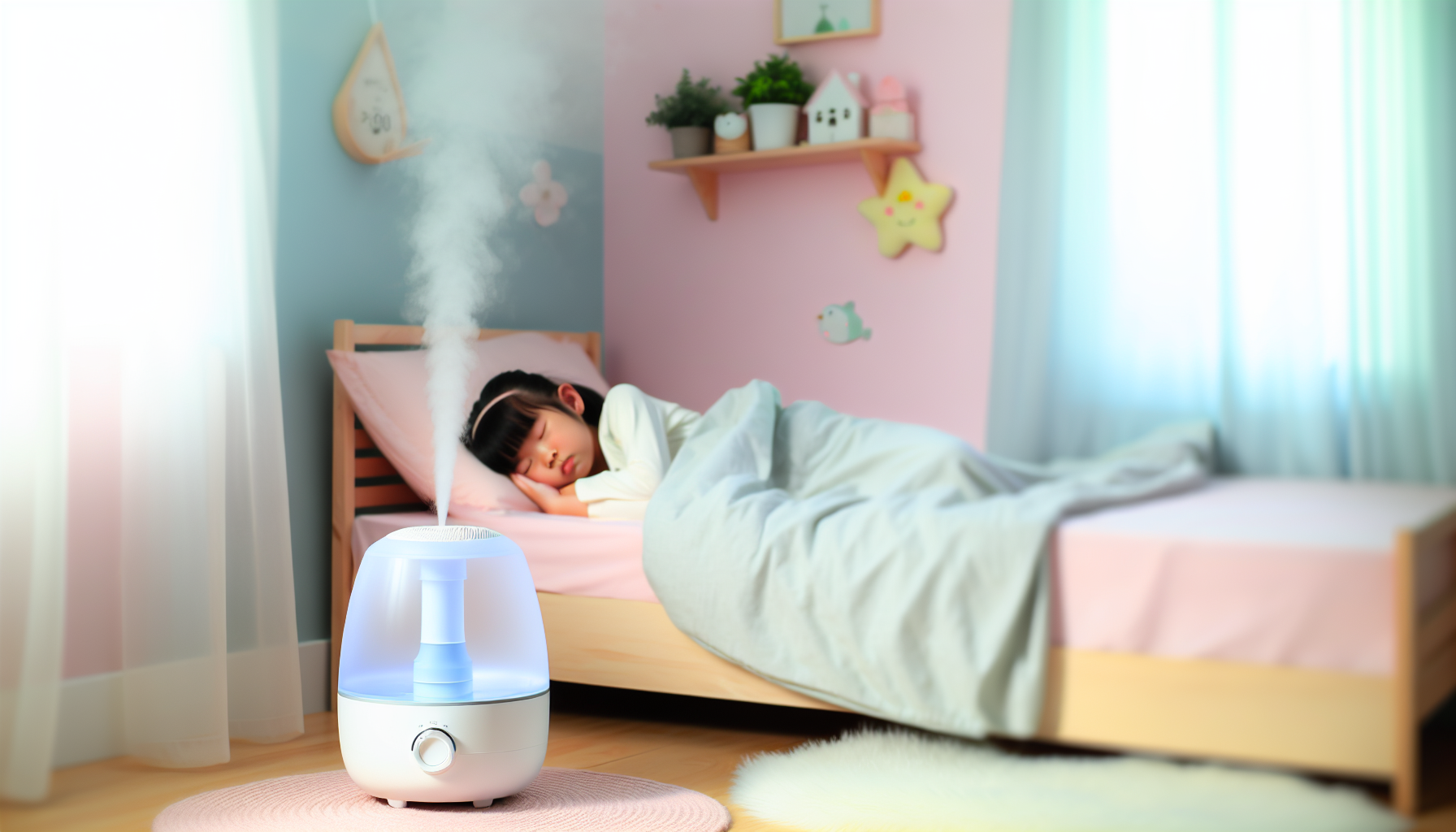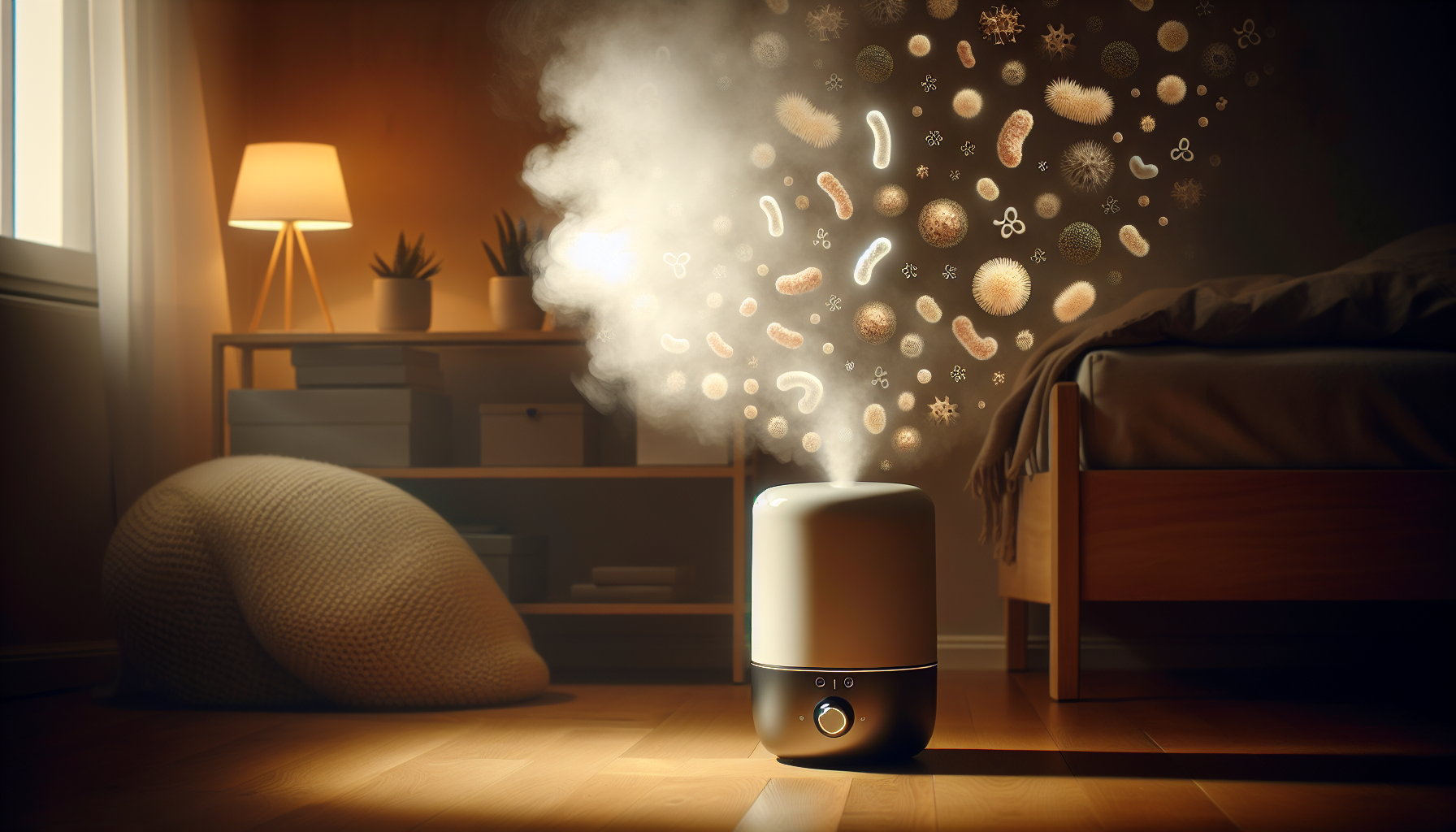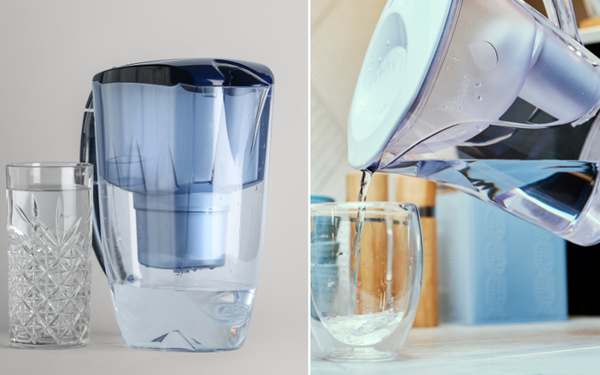Is it better to use cool or warm mist humidifier? Choosing between a cool or warm mist humidifier can be challenging. This guide clearly outlines the differences and effects of both, considering factors such as health benefits, climate suitability, and operational costs. Make an informed choice on which humidifier is best for you with our straightforward advice on “is it better to use cool or warm mist humidifier.”
Key Takeaways
- Cool mist humidifiers come in two main types: evaporative and ultrasonic, and are particularly safe for households with children and pets, while warm mist humidifiers provide comforting warmth ideal for colder climates but have higher energy consumption.
- Both cool and warm mist humidifiers need regular cleaning to prevent bacteria and mold growth, but warm mist humidifiers inherently minimize microbial presence due to their heating process.
- Humidifiers should be selected based on personal preferences, local climate, specific health concerns, and noise levels, with dual mist humidifiers offering a versatile solution for various conditions and seasons.
Understanding Cool and Warm Mist Humidifiers

When deciding between cool mist humidifiers and warm mist humidifiers, understanding their differences is crucial. The main distinction lies in their operation: cool mist humidifiers disperse room-temperature mist, while warm mist humidifiers heat water to produce warm vapor. Cool mist humidifiers typically use an internal wick filter and a fan to distribute the cool moisture. On the other hand, warm mist humidifiers generate a cozy, comforting mist that is especially soothing during colder months.
The most suitable humidifier for you depends on various factors such as your household’s needs, local climate, and personal preferences. Whether you opt for a cool or warm mist unit, it is key to remember that both types of humidifiers are designed to increase humidity levels in the air, providing relief from dry heat and creating a more comfortable living environment.
Cool Mist Humidifiers: Evaporative and Ultrasonic
Cool mist humidifiers come in two variants: evaporative and ultrasonic. Evaporative models work by using a fan to draw air into the unit, and through a wet wick filter, evaporating water into the air. On the other hand, ultrasonic humidifiers operate slightly differently. They use a small metal or ceramic disk vibrating at an ultrasonic frequency to create a fine mist, which is then released into the air.
While both variants effectively increase humidity levels, they have distinct advantages. Ultrasonic humidifiers are generally quieter and more efficient at humidifying larger areas, making them a popular choice for big rooms or open-plan living spaces. Meanwhile, evaporative models are often preferred in homes with pets and children, thanks to their safety features and robust design.
Warm Mist Humidifiers: How They Work
Warm mist humidifiers employ an internal heating element to boil water, which is then released into the room as steam. This steam not only increases room humidity but also provides warmth, making these units a comforting presence during cold seasons. Moreover, the high temperatures in the heating process offer better protection against bacteria and germs present in the water.
However, there’s a trade-off. Unlike cool mist humidifiers, warm mist models may be less effective in larger areas due to the absence of an internal fan to disperse the mist broadly. That said, they still have a place in households, especially for those seeking a quiet humidifier, as these units tend to operate more silently thanks to the lack of a fan.
Advantages and Disadvantages of Cool Mist Humidifiers

In addition to their operational differences, cool mist and warm mist humidifiers each have their benefits and drawbacks. Cool mist humidifiers are particularly recommended for households with children and pets, due to the absence of hot water, reducing the risk of burns or injury. They are also notably energy-efficient, as they do not require heating water, which can lead to lower electricity costs.
However, one potential downside to cool mist humidifiers is noise. They may produce more noise compared to warm mist models due to the fan or ultrasonic mechanisms involved in mist creation. This is something to consider if you’re planning to use your humidifier in a quiet space, such as a bedroom or study.
Safety Concerns
Safety is a paramount consideration when choosing a humidifier, especially for households with young children or pets. Cool mist humidifiers are generally safer than warm mist types, as they do not use hot water that could cause burns. On the contrary, warm mist humidifiers pose a scalding hazard due to the hot water vapor they emit, which can be particularly dangerous if children or pets tamper with the unit.
However, safety isn’t only about the risk of burns. It’s also about air quality. For instance, ultrasonic cool mist humidifiers can introduce bacteria, chemicals, minerals, and mold into the air when they aerosolize tap or bottled water, leading to potential lung issues if inhaled. On the bright side, evaporative cool mist humidifiers are a safer option as their filter system prevents the emission of bacteria or minerals, and they produce cool vapor instead of aerosolizing water, despite the need for regular filter changes.
Energy Efficiency
Energy efficiency is another crucial factor to consider when choosing a humidifier. Cool mist humidifiers do not require heating water, which makes them more energy-efficient compared to warm mist models. This can lead to lower electricity costs, making cool mist humidifiers a cost-effective choice in the long run.
Moreover, some humidifiers are equipped with hygrometers or humidistats, which automatically adjust to maintain moisture at a healthy level—this feature can further enhance energy efficiency. So, you don’t only save on your energy bills, but you also ensure that your indoor air has just the right amount of moisture.
Noise Levels
The noise level of the humidifier is an important factor to consider, especially if you’re planning to use it in a bedroom or study area. Noise can impact the comfort and potentially the sleep quality of users. Ultrasonic humidifiers are regarded as the quietest type of cool mist humidifier due to their high-frequency vibration technology that operates with virtually no noise.
On the other hand, evaporative cool mist humidifiers may produce more noise compared to ultrasonic models because they utilize a fan to evaporate water into the air. However, they often come with variable fan speeds that allow you to adjust noise levels according to your preference. Therefore, if you’re sensitive to noise, it’s worth considering these factors when choosing between different cool mist models.
Advantages and Disadvantages of Warm Mist Humidifiers

Warm mist humidifiers also come with their set of pros and cons. While they generate a comforting warmth that’s particularly beneficial in colder climates, they consume more electricity than cool mist units, making them less energy-efficient. The absence of a fan in warm mist humidifiers offers a quieter operation, which is preferable for light sleepers or for use in bedrooms.
While warm mist units may not be the top choice for energy-conscious consumers, they do come with other benefits. For instance, they provide a cozy atmosphere in the home during cold months and offer better protection against bacteria and germs present in the water.
Warmth and Comfort
One of the major advantages of warm mist humidifiers is the added warmth they provide. They can make a room feel slightly warmer, which is beneficial during colder seasons. If you live in a cold climate, the added warmth from these humidifiers may be particularly beneficial by subtly raising the room temperature.
Moreover, the warm mist released by these humidifiers contributes to a cozier atmosphere within the home, making them a comforting presence during winter. This can help alleviate the discomfort of dry, cold air and create a more soothing environment, especially at night, by introducing moist air.
Bacteria Growth Prevention
Warm mist humidifiers also have a unique advantage when it comes to bacteria and mold prevention. Their heating process reduces the likelihood of bacteria and mold spore production as many organisms are killed during the process. However, while they kill bacteria in the water, the warm mist from these humidifiers can foster an environment conducive to mold growth in the room if not properly managed.
Regular cleaning of warm mist humidifiers is essential to prevent mineral buildup and the growth of microorganisms. Even though the heating process disperses fewer bacteria and molds, proper maintenance is necessary to ensure the cleanliness and safety of the unit.
Energy Consumption
On the flip side, a potential drawback of warm mist humidifiers is their higher energy consumption. They use more electricity than cool mist units because it takes more energy to heat the water to produce steam. This additional energy consumed is primarily due to the heating process required to generate warm vapor, which may slightly reduce their energy efficiency.
Despite their higher operating costs due to energy consumption, they can be cheaper to purchase than some cool mist humidifier models. Therefore, if you’re more concerned about upfront costs rather than long-term operating costs, warm mist humidifiers might be a suitable option for you.
Factors to Consider When Choosing a Humidifier

Now that we’ve dissected the advantages and disadvantages of both cool and warm mist humidifiers, let’s look at the factors that can influence your decision when choosing a humidifier. Three main factors come into play: personal preference, climate and seasonal needs, and specific health concerns.
Whether you prefer a quiet unit for your bedroom, an energy-efficient model for your office, or a humidifier that can help alleviate your allergy symptoms, your personal needs and preferences should guide your choice. Understanding your requirements will help you navigate the plethora of options available and select the best humidifier for your needs.
Personal Preference
Personal preference plays a crucial role in selecting a humidifier. Each individual prioritizes different features such as noise levels, energy efficiency, and user-friendliness according to their specific desires and needs.
Do you prefer a quiet humidifier for your bedroom or a powerful one for your large living room? Are you looking for an energy-efficient model to save on electricity bills, or do you prefer a warmer mist for comfort during cold seasons? Answering these questions will help you narrow down your options and choose the humidifier that best suits your personal preferences.
Climate and Seasonal Needs
Your local climate and seasonal needs should also influence your choice of humidifier. For instance, cool mist humidifiers can lower the temperature in a room slightly, making them well-suited for use in dry, warm climates. They add moisture without increasing the room’s heat, providing comfort during warmer months.
On the other hand, warm mist humidifiers are often the choice in colder climates or during winter, as they add humidity along with a warming effect to the environment. Therefore, the climate and season in your location should be taken into account when choosing between a cool and warm mist humidifier.
Specific Symptoms and Health Concerns
Last but not least, your specific health concerns and symptoms can influence your humidifier choice. For instance, cool mist humidifiers are generally recommended for:
- Congestion relief
- Easing congestion and stuffy noses by adding moisture to the air
- Maintaining a humidity level between 30-50% to provide relief from cold and congestion
- Helping nasal passages filter out bacteria and pathogens more effectively
On the other hand, warm mist humidifiers offer a soothing warmth that can help alleviate cold symptoms such as coughs, by soothing the throat and respiratory passages. Therefore, if you have specific health concerns or conditions, these should be considered when choosing a humidifier.
Tips for Proper Humidifier Use and Maintenance

Now that you have a better understanding of the different types of humidifiers, let’s look at some tips for their proper use and maintenance. Regular cleaning and sanitizing, filter replacement, and using appropriate water quality are crucial aspects of maintaining your humidifier.
Proper maintenance not only ensures the longevity of your unit but also maintains optimal performance and prevents potential health issues. Therefore, whether you choose a cool or warm mist humidifier, these tips will help you keep your device in the best possible condition.
Cleaning and Sanitizing
Regular cleaning and sanitizing of your humidifier are crucial for its optimal performance and for maintaining a healthy environment in your home. To clean and sanitize your humidifier, you should wash and rinse the water reservoir, remove accumulated dust, and regularly use a sanitizing agent like bleach or white vinegar.
For a deep clean, use a bleach solution following a specific dilution ratio, allow it to sit for a set time, and then perform multiple rinses to eradicate traces of bleach odor before drying the parts. Maintaining your humidifier’s hygiene and safety includes refreshing the water daily and cleaning the unit at least weekly. Remember to unplug the unit before cleaning, avoid harsh chemicals, and be mindful of potential health risks such as bacteria and mold.
Filter Replacement
Regularly checking and replacing the humidifier’s filter is also crucial for maintaining optimal performance. It’s recommended to replace the humidifier filter every 1-2 months or sooner if it has an odor or feels crusty to prevent bacteria accumulation.
However, don’t try to clean the wick filter, as this could damage it. Instead, replace it if it’s dirty. Flipping the filter each time you refill the tank can help it wear more evenly, extending its lifespan. Always follow the manufacturer’s guidelines for the timing and process of filter replacement.
Water Quality
The quality of the water you use in your humidifier can have a significant impact on its performance and the quality of the mist it produces. Tap or bottled water in cool mist humidifiers can create ‘white dust’, while using distilled water minimizes bacteria growth due to fewer minerals present.
Distilled or purified water from a reverse osmosis process is recommended for humidifiers as it contains very low mineral content and is also free from other contaminants. The EPA recommends using distilled water to ensure the release of safe, healthy mist from humidifiers.
Dual Mist Humidifiers: The Best of Both Worlds?
If you’re still having trouble deciding between a cool and warm mist humidifier, why not consider a cool mist model with dual mist functionality? These devices offer both warm and cool mist options, providing flexibility based on personal needs and seasons.
Models like the Levoit OasisMist 450S Smart Humidifier provide additional features such as:
- Large water tank capacity
- Quiet operation
- Digital display
- Smart connectivity
These features offer an enhanced humidifying experience while maintaining ideal humidity levels between 30% to 50% in the home.
Summary
In conclusion, the choice between a cool mist and warm mist humidifier ultimately comes down to your personal preferences, climate, and specific health concerns. Both types have their advantages and disadvantages, and understanding these can help you make an informed decision. Remember, the best humidifier for you is one that meets your unique needs and creates a healthier, more comfortable environment in your home. Happy humidifying!
Frequently Asked Questions
Why is cool mist better than warm mist?
Cool mist humidifiers are generally preferred over warm mist humidifiers because they cover more space and do not have a heating element, making them safer around children. Additionally, cool mist humidifiers may help ease coughing and congestion due to colds.
When should you use a warm mist humidifier?
You should use a warm mist humidifier during the winter months to make the room feel warmer and to infuse the air with soothing vapor, especially when you want to add medicines for respiratory relief.
What is the healthiest type of humidifier?
The healthiest type of humidifier is a cool-mist humidifier. It helps shrink swelling in nasal passages and is recommended for households with babies and young children.
What are the main differences between cool and warm mist humidifiers?
The main differences between cool and warm mist humidifiers are the temperature of the mist they disperse and the method used to produce vapor. Cool mist humidifiers spread room-temperature mist using a wick filter and fan, while warm mist humidifiers heat water to produce warm vapor.
Which humidifier is more energy-efficient?
Cool mist humidifiers are more energy-efficient than warm mist humidifiers, as they do not require heating water. However, some warm mist humidifiers with hygrometers or humidistats can automatically adjust moisture levels for improved efficiency.










